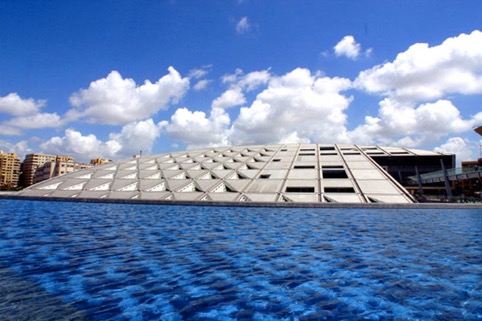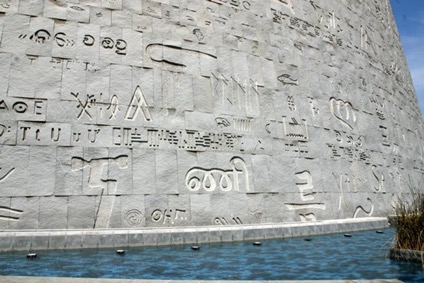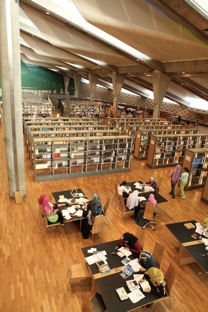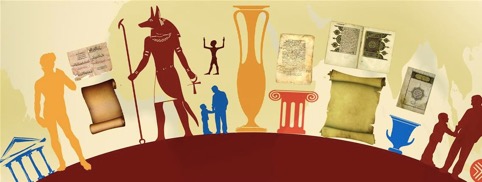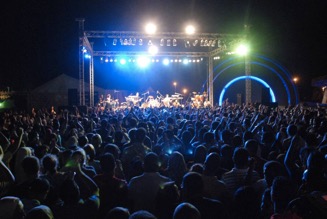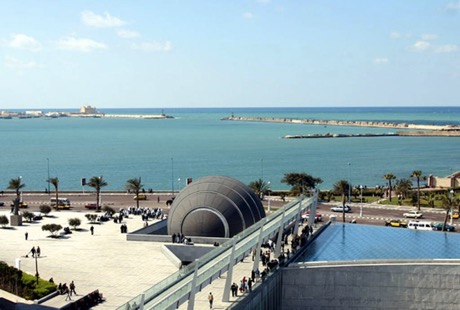The account of the city’s founding continues in Arrian’s Anabasis of Alexander (3.I.5-2.2),[2] where Alexander, who travelled to Kanobos and sailed around Lake Mareotis to select an appropriate site, decided to locate his city. Once he had planned out the city, determining the location of the Agora and establishing the sanctuaries and temples for the various deities ? both “Greek gods and Egyptian Isis” ? Alexander sacrificed to the gods and when he received favorable signs, he laid out the city walls; however, since he had nothing with which to mark out the parameter of the city, he used meal that his soldiers carried with them. While there is disagreement about the precise date of the founding of Alexandria, some have suggested that this event may have occurred in 332 or 331 BCE. Shortly after founding the city, Alexander left the actual building and administration of the city to others and, moving his campaign further east, was never to return to his city. Certainly, current scholarship is critical of the foundation stories surrounding the origins of Alexandria; many of the authors in this collection of essays, Alexandria: A Cultural and Religious Melting Pot, emphasize persistent difficulties with sources and the tendency for various ancient authors to mythologize the founding of the city. According to Krasilnikoff, however, “the first citizens of Alexandria were also soldiers in Alexander’s and Ptolemy’s armies” (“Alexandria as Place,” 21). Hence, it is not surprising that Greek and Egyptian cultural forms and content should be intertwined in Alexandria. Citing Heracleides, Plutarch notes that Homer, who “was no idle or useless companion” accompanied Alexander on his campaign (“Alexandria as Place,” 21).
Indeed, the ancient city was a center of scholarship and intellectual activity with the Alexandrian Library and the Museum, and much of the early Homeric scholarship was done in Alexandria; even the form of the Iliad and the Odyssey as we have received these works each having twenty-four books was first codified by scholars working in these institutions. To be sure, other groups also helped write the history of the city. Jews were apparently among the earliest inhabitants of the city. Philo the Jewish thinker, known for his skeptical epistemology, worked there. As Per Bilde argues in his paper, “Philo as a Polemist and a Political Apologist: An Investigation of his Two Historical Treatises Against Flaccus and The Embassy to Gaius,” while he has not been recognized as such, Philo was also a polemist and a political apologist for the significant Jewish population of the city, and, according to Josephus, led the delegation to Gaius to plead for the Jews. Moreover, Alexandria belonged to the Roman Empire and under the influence of Clement and Origen it was a significant center, along with Antioch and Rome, in the development of early Christianity.
Alexandria: A Cultural and Religious Melting Pot is the ninth volume in the Aarhus Studies in Mediterranean Antiquity (ASMA) series published approximately once a year by The Centre for the Study of Antiquity, University of Aarhus, Denmark. Edited by George Hinge and Jens A. Krasilnikoff, the eight papers in this volume were selected from among those presented by a number of scholars from different countries, including Denmark, Sweden, and the United States, at the May 2004 seminar on Alexandria hosted by the Centre; other papers were also included later. The eight papers in this volume are divided into two sections, entitled: “Part I. Alexandria from Greece and Egypt” and “Part II. Rome, Judaism and Christianity.” Each paper in this text is well-researched and is followed by a rich bibliography. While the authors are critical of the mythological accounts of the founding of Alexandria, the ancient sources are not simply rejected out of hand; rather, despite the problematic character of ancient sources, these sources along with their scholarly interpretations are examined carefully and critically with an eye to understanding the city the cultural and religious diversity of its people. The authors represented in Alexandria are also aware of and discuss the tendency of some sources to distort their facts in their enthusiasm for a particular historical point of view or outcome. While one must use the available sources, we must keep in mind that religious conflicts, for example, between Pagans and Christians tend to be written by the victors. One advantage that the scholars writing for this publication have had, however, is the enormous growth in the scholarship of Egypt and north Africa during the last thirty years and the increase in the availability of the number of papyri manuscripts and other relevant evidence from these regions. Another theme common to the papers in this collection is the view that cultures are extremely complex, living organisms and not ‘static things’. Thus, in his essay, “Alexandrian Judaism: Rethinking a Problematic Cultural Category,” Anders Klostergaard Petersen, citing Martjin van Beck, objects to “a static model” of culture – one that
… gives a distorted picture of the cultural and social reality of human beings, past and present. Culture – and religion as well as part of the cultural construction – should rather be seen as ways of interpreting the world. Culture represents what one does and not what one is. Martjin van Beck has poignantly emphasized this point. He underlines to what a great extent the talk about cultures is itself part of the cultural construction: “The point is not to deny that common features exist in particular fields but to document that the extrapolation from specific similarities and differences to homoginised, cultural and even civilizing units is a creative process and not just a mapping of already existing facts” (Petersen, 123).[3]
Indeed, reminding us of Alfred Korzybski’s observation “that the map is not the territory,” Peterson writes, “Cultures are by their very nature ‘messy’ or hybrid affairs” (124 and 125).[4]
The four papers of the first part take up in various ways “the relationship between Ptolemaic Alexandria and its Greek past” (Hinge and Krasilnikoff, “Introduction,” 10). Jens A. Krasilnikoff launches the volume with his paper, “Alexandria as Place: Tempo-Spatial Traits of Royal Ideology in Early Ptolemaic Egypt.” Specifically, Krasilnikoff is interested in the way that Egypt as space is transformed into Alexandria as place. Borrowing from the work of humanistic geographers like Yi-Fu Tuan, Peter J. Taylor, and Jonathan M. Hall, he examines this problem by considering the concepts of “space,” “place,” and “identity.” Citing Tuan’s Space and Place: The Perspective of Experience, Krasilnikoff observes that the concepts of ‘space’ and ‘place’ are “interdependent” (Krasilnikoff, 23).
… the meaning of space often merges with that of place. “Space” is more abstract than “place”. What begins as undifferentiated space becomes place as we get to know it better and endow it with value … The ideas “space” and “place” require each other for definition. From the security and stability of place we are aware of the openness, freedom, and threat of space, and vice versa. Furthermore, if we think of space as that which allows movement, then place is pause; each pause in movement makes it possible for location to be transformed into place (23).[5]
Interdependence of space and place and the relationship between these two concepts “determine the formation of different kinds of identity”; hence, we can distinguish “identity of place” which “includes the identity markers that constitute a particular place,” and “place identity” which “involves those qualities of a place that helps generate identities of individuals or groups.” Krasilnikoff, uses these concepts to explore the meaning of “place within the Egyptian context of the Ptolemaic period”; indeed, he wants to understand how “the Greek concept of the ‘city-state culture’ and society developed in this distinct framework” that is Alexandria (38). For Kasilnikoff, then, Alexandria is to be understood in the Greek polis tradition because of its founding and the heroic character of its founder; this view was reinforced by the Ptolemaic rulers who claimed to be direct descendents of Alexander and by ancient authors who apparently borrowed their conceptions of the founding from other founding myths. At the same time, examining the earliest history of the city leads Krasilnikoff to conclude that Alexandria “differed fundamentally from the majority of classical and Hellenistic cities” (Hinge and Krasilnikoff, “Introduction,” 10).
In her paper, “Theatrical Fiction and Visual Bilingualism in the Monumental tombs of Ptolemaic Alexandria,” Marjorie Susan Venit notices that in the very beginning of Alexandria the inhabitants created “monumental tombs as communal spaces for both burial and veneration of the dead” in the limestone on which the city stands (Venit, 42). These tombs, Venit observes, are “unique” to the city, “and, until their dissemination across the north coast of Egypt and to the eastern Mediterranean, they stand unparalleled as monuments to a complex vision of the afterlife.” Illustrating her paper with five diagrams and eight pictures of the tombs, she notes that elements of two “disparate” traditions are brought together in the construction of the tombs. First, “Egyptian elements” are incorporated “into the fabric of an initially and fundamentally Hellenically-inspired monument.” The second element that interests Venit is that the tombs include theater. Hence, the tombs and monuments combine two “culturally distinct architectural traditions and … two ethnically discrete visual systems as well.” The tombs, according to Venit served as “a purposefully designed space within which, and against which, the human drama of the funerary ritual” was performed. While the dead were entombed in these monuments, the buildings also served a symbolic function making an “external reference” that allowed an extremely diverse population to identify themselves as Alexandrians. It is precisely this that makes the Alexandrian tombs unique. “Both visions,” Venit writes:
… bilingualism and theatricality – incorporate into their fabric the fiction that is the underlying basis of Ptolemaic period Alexandrian tombs, and both fictive situations apart and in concert, establish the mortuary buildings of Ptolemaic Alexandria as bi-cultural monuments that can only have had their genesis in the peculiar construct that was ancient Alexandria. It is this bi-ocular modality that separates characteristics to express the singular eschatological vision that marks the monumental tomb of ancient Alexandria (64).
George Hinge takes up the ever-controversial subject of race in his essay, “Language and Race: Theocritus and the Koine Identity of Ptolemaic Egypt. ” Hinge cites Herodotus’Histories to show that “Greek ethnicity” is determined by “four components: origin, language, cult, and culture” (Hinge, 67). In this passage, Hinge refers to words spoken by the Athenians to a Laconian delegation, arguing for a coalition to fight against the Persians.
There are many reasons why we should not do this, even if we wanted to: First and foremost, they have burnt and destroyed the statues and temples of our gods, and we are obliged to revenge them as far as possible rather than conclude a treaty with the offenders. Furthermore, there is the Hellenicity, consisting in the same blood and the same language, the common shrines of gods and cult and the same way of life, which the Athenians should not betray (Herodotus, Histories, 8.144.3; Hinge’s underling).
Thus, Hinge argues, “language is quintessential to Herodotus’ concept of ethnicity” (68). In this Hinge is arguing against Jonathan Hall, who in his Ethnic Identity in Greek Antiquity holds the view “that language played only a minor role in the formation of ethnic groups” (Hinge and Krasilnikoff, “Introduction,” 11).[6] Hinge argues that while it may have mattered “what sort of Greek you are” ? whether one was a Spartan, an Argive, or an Athenian ? in the Greek homeland, once the colonization of the eighth and seventh centuries BCE got underway, “a Greek identity” began to emerge “in opposition to the non-Greek natives in Cyprus, Egypt, Libya, Sicily, Italy or Scythia. The otherness of those ‘Barbarians’ and the complete unintelligibility of their languages, which were frequently compared to the chirping of birds, made the existence of a specific Hellenic identity obvious” (Hinge, 69). This identity, as Hinge emphasizes, “is not natural per se, but a cultural construction” that has its origins in the Mycenaean Age and that leads to “the creation of a Koine.” That Koine displaced local dialects, Hinge argues, was not just a way to bridge various local languages and dialects, “but the symptom of a new identity, and not only a symptom, but also a most powerful contribution to that identity” (77).
In her “Homeric Scholarship in Alexandria,” Minna Skaffie Jensen describes the Alexandrian Museum and the research conducted by the scholars working there especially the work done on Homer. According to Jensen, Demetrius of Phalerum, an Athenian scholar and one of Aristotle’s students was responsible for organizing the Alexandrian Library; not surprisingly, it was modeled on Aristotle’s library in the Lyceum. While he was active in politics and even ruled Athens for the Macedonians (317-7 BCE); he also continued to work with the Library and is credited with having had Aesop’s fables written down. Jensen engages a number of scholars’ interpretations of the origins of the Homeric texts, including, Martin West, Antonio Rengakos, Gregory Nagy, Stephanie West, and others. She concludes her brief history of the Library and Museum and of the Homeric scholarship that took place there lamenting that, despite the problems, the view “we get in the sources does not confirm the picture of the Library as an important participant in the great interaction of cultures and religions. On the contrary, the philologists of the Library appear to have been concerned with Greek literature and nothing else” (Jensen, 89). Apparently Egyptian texts were left to the priests. While the subtitle of this collection of essays is, “A Cultural and Religious Melting Pot,” and while there is evidence in other fields for a melting pot, with regard to the Library perhaps it was not quite so. “The Ptolemaic rulers of Egypt,” Jensen writes,
… achieved nothing more important than the superb intellectual milieu established at the Museum. Whatever their intentions, the results of their generous support of learning are remarkable. To them we owe infinite gratitude for the fact that ancient Greek texts have reached us in such quantity and quality Scientific and scholarly method was developed to a previously unknown level. Poetry flourished. And just as Alexandrian poets become the stimulating ideal for Roman poets from Ennius onwards; the Ptolemies offered themselves as worthy models for the patronage of the artists practiced in Augustan Rome (91-92).
The first two of the four essays constituting “Part II. Rome, Judaism and Christianity,” are devoted to Judaism. In the first piece, “Philo as a Polemist and a Political Apologist: An Investigation of his Two Historical Treatises Against Flaccus and The Embassy to Gaius,” Per Bilde considers two texts by Philo, an extremely influential Jew from one of the most important and prosperous Alexandrian families to show that although Philo is usually known for his work in theology, epistemology, and metaphysics, he also played an significant role as a politician, a polemist, and a political apologist, especially between 38 and 41 CE – “a period of great importance in the history of the Jewish people in the ancient world” (Hinge and Krasinikoff, “Introduction, 13). In his essay, Bilde reconstructs the historical and political events in the year 38 CE, the year of what has become known as “the first pogrom” against the Jewish people. Then, he analyzes Philo’s two historical treatises Against Flaccus and The Embassy to Gaius. Finally, Bilde examines “the literary genre and the aim, dating and intended readers” of these two works and considers whether Philo’s writings “could be perceived as a threat to Rome” (Bilde, “Philo as a Polemist and a Political Apologist,” 98).
As Bilde explains, Judaism had flourished in Alexandria for many years and “continued to thrive well over the first year of Caligula’s rule (37-38 CE)” (Hinge and Krasilnikoff, “Introduction,” 13). Aulus Avilius Flaccus was a Roman prefect in Alexandria and Egypt (32-38 CE). While “the living conditions for the Jewish people,” according to Bilde, were generally not bad “in the Roman empire from Caesar (died 44 BCE) and Augustus (31BCE-14 CE) until the summer of 38,” for reasons that are not evident, Flaccus “seems to have cancelled the Jewish population’s established right to live in Alexandria according to the customs of their fathers and under some kind of internal self-government …” (Bilde, 99). When King Agrippa I, also known as Herod Agrippa, (37/41-44) who had recently been crowned King of Palestine stopped in Alexandria en route from Rome to his homeland, his visit set off riots against the Jewish people. Non-Jewish residents of the city also tried to set up statues of the emperor in synagogues. Instead of trying to stop the riots, Flaccus, and here Bilde follows Philo’s account, sided with the “‘Greeks’ and issued a decree … denouncing the Jews as ‘foreigners and newcomers’ … in Alexandria” (100). Subsequently, Jews were driven out of four of the five parts of the city and ghettoized into the remaining fifth part. Jews were the subject of violent attacks, some were flogged publically, some were killed, and some were forced to violate religiously sanctioned dietary prohibitions by eating pork. Although Bilde cautions: “when reconstructing historical circumstances in Antiquity, from using terms related to the European persecutions of Jews in the Middle Ages and in recent times” (101), he also claims that “this violent persecution of Jews seems to be something new in Antiquity” (100). Eventually, Flaccus was arrested by the Emperor, returned to Rome, where after his property was confiscated, he was sent into exile and eventually put to death by the emperor. According to Bilde, then, Philo’s Against Flaccus is begins with a glowing report of Flaccus’ first six years in office only to explain Flaccus’ fall from office; indeed, it is a cautionary tale that proclaims the power of the god of the Jews and explains that those who violate the Jewish people will face a fate similar to Flaccus’. On the one hand, Bilde interprets the texts as being written for the Jewish people in a “traditional and effective Jewish literary form or genere, religious apologetics,” which was later adopted by Christians; Philo’s apologetic texts were meant “to comfort and edify Jewish readers” and should be compared to the Book of Esther of the books of the Macabees (109). On the other hand, however, Bilde suggests, is that Philo wrote in “this form or genere “for Roman readers, primarily the new Roman emperor, Claudius, the new imperial prefect in Egypt, Pollio, and other leading Roman circles …” as if to warn them against actions that might harm the Jewish people and blaspheme their god.
In his paper, “Alexandrian Judaism: Rethinking a Problematic Cultural Category,” Anders Klostergaard Petersen takes a quite different approach from Bilde’s, for he is not interested in well-known writers like Philo nor is he interested in “the empirical subject matter of Alexandrian Jewry” (Petersen, 116); rather, Petersen’s paper is much more ambitious and is focused on the theoretical problem of how to reconstruct past cultures. Petersen begins by briefly sketching out the history of Jewish people in Alexandria. Then, he examines “Alexandrian Judaism with close attention to a number of theoretical problems that are infrequently mentioned in the predominant strands of scholarship.” Finally, Petersen concludes by offering “a theoretically viable way of reconstructing ancient cultures in a manner that is simultaneously theoretically adequate to the acknowledgement of the confined nature of the sources, and to current insights within the fields of cultural anthropology and sociology of how to speak and to conceive of culture.” Petersen is critical of approaches to culture that assume one individual, such as Philo, Aristeas, or Artapanus, can speak for or represent a particular culture or subculture. While contemporary scholarship seems to understand this, Petersen maintains that even though many contemporary scholars acknowledge this problem, they proceed to deal with their sources without considering the consequences of taking “one trajectory of thought” as the embodiment of an entire cultural entity. Indeed, “the banalities of culture and the platitudes of human beings,” Petersen writes, “are seldom handed down” (118). On the other hand, he does not argue that scholars should ignore available sources; rather, the solution is to keep “the constrained nature of the majority of the extant sources” and to reflect on the “wide strands of scholarship, current as well as classical, on Alexandrian Judaism” (119). Petersen is also critical of those who understand Philo in terms of a preconceived dualism of Hellenism and Judaism. This dualistic view, Petersen argues is “theoretically flawed” for several reasons (124).
First, even the most vehement Jewish antagonist of Greek thinking is culturally as well as socially inevitably enmeshed in what he opposes …. Secondly, the use of a notion like “Hellenism” is always contextually bound. It relates to particular traits only within the other culture. It is never a comprehensive term that refers to the entire plethora of phenomena of the “other culture. “Jerusalem” and “Athens” are unfailingly entities that are rhetorically used in particular contexts to refer to specific phenomena. Thirdly, the abstract taxonomic play with terms like Judaism and Hellenism in modern scholarly discourse is very far from their use in antiquity. That … does not invalidate contemporary use, but it certainly should put some restraints on the manner in which they are used (125).
One must remember that a thinker like Philo is a Jew, but also an Alexandrian; even Philo himself is not a simple unity; “Philo’s writings should be interpreted as the creations of a composite being who under particular circumstances and with particular aims and situations in mind attempts to conquer the cultural battlefield of his time” (139). Still, this does not mean that we should speak of “Alexandrian Judaisms or Jewries” instead of “Alexandrian Jewry / Judaism” (Petersen, 128). While this may have “heuristic value,” it is “misleading” because it indicates the inability “to distinguish a concept and a phenomenon.” Alexandrian Judaism may only be a construct of contemporary scholarship. On the other hand, Petersen suggests, following Benedict Anderson, that although “Alexandrian Judaism was hardly a community characterized by ‘the primordial village of face-to-face contact,’” it could still be understood as “‘imagined community’” because “its members constituted a conscious community” that “shared the common frame of reference of being Jews of Alexandria.” In end, Petersen concludes, “however perplexed we may be as a result of engagement with cultural ‘messiness,’ the great intellectual challenge for future studies not only on past Alexandrian Jewry, but on ancient cultural entities in general, will be to take the ‘messiness’ of human cultural and social affairs profoundly seriously” (140).
In “From School to Patriarchate: Aspects on the Christianisation of Alexandria,” Samuel Rubenson is not concerned with religion or theology; rather, he focuses on “the transformation of the classical heritage into an early medieval Christian culture” and the important role that Alexandria played in that transformation (144). Indeed, Rubenson argues that this transformation must be understood “from a social point of view” (145). The importance of Alexandria to the development of Christianity with development of Christian theology and the revision of classical philosophy is unequaled until “the emperor and the bishops of Rome and Constantinople … ended the ecclesiastical power by means of the council of Chalcedon in 451.” Origen of Alexandria was important for his work in “Christian hermeneutics and Bible interpretation”; indeed, according to Rubenson, he was the most important Christian teacher of this period. Athanasius of Alexandria is acknowledged for his interpretation of the divine as trinity and his efforts to define church dogma. Cyril of Alexandria addressed himself to the problem of how Jesus as Christ could be both man and god. The work of later Christian thinkers, such as Augustine, the Cappadocians, Maximus the Confessor, and John of Damascus are certainly based on Origen, Athanasius, and Cyril. Rubenson concludes that our understanding of early Christianity in Alexandria, then, is based on the work of Christian teachers and philosophers, who instituted a tradition of Christian schools during the second century, and who were recognized for their work both in Alexandria and in the larger emerging Christian community. Schisms and a break between the church and the school were caused by “the severe and prolonged persecutions of the Christian leadership of Alexandria in 303-11” (156). Emperor Constantine’s recognition of the bishop of Alexandria elevated the importance of the bishops and gave them increased responsibilities. The bishops, who attempted to unify the church and unite the Christian community in the face of the pagan traditions that were embraced by parts of the Alexandrian elites, were resisted by intellectuals living independently on the edge of the desert south of the city. Uniting with local authorities, the bishops received the support of the emperor to unite Christians against their Christian opponents and critics and the remaining pagans.
In “Religious Conflict in Late Antique Alexandria: Christian Responses to ‘Pagan’ Statues in the Fourth and Fifth Centuries CE,” Troels Myrup Kristensen begins where Rubenson ends with the conflict between the Christian bishops and the continued pagan tradition of parts of the Alexandrian elite. Noting the complicated religious, social, and political tensions that were part of the Mediterranean world of the fourth and fifth centuries, Kristensen contextualizes his discussion of the conflict between Christians and pagans by tracing Christian opposition to pagan statuary to “the Judaic tradition and the Mosaic prohibition against idolatry” (160). While wooden statues were burned, stone statues were either defaced or “reinterpreted” by adding crosses or other Christian symbols to the statues by Christians (161). At the same time, Kristensen emphasizes that these views were not held by all Christians and that some pagan statues survived in Christian households. Illustrating his paper with three photographs, one diagram, and one map, Kristensen discusses the destruction of the Serapeum and its statuary in 392 CE which along with “the murder of the philosopher Hypatia” are “among the best known cases of religious violence in Late Antiquity” (162). Christian destruction of pagan statuary is one of the reasons that pagan statuary was cached and pagan practices were driven underground. Kristensen concludes by noting that the violence brought on by the religious and social transformation in Alexandria in Late Antiquity was rampant; indeed, it can be understood “as the result of the ‘brutalisation of local politics’ or ‘progressive Christianisation’” (172). While there is much literary evidence for the Christian destruction of statuary, actual evidence is much more difficult to obtain. One of the problems is that most of the surviving accounts of this period of Alexandrian history are from Christian sources. “The bias of the Christian literature concerning the ‘end’ of pagan cult at Alexandria makes it difficult to accept them at face value.” Archaeological evidence is also problematic because interpretation and documentation are difficult. Still, Kristensen argues, we can rough out Christian reactions to paganism and pagan statuary.
Hinge and Krasilnikoff are to be commended for bringing together the papers in this volume; indeed, Alexandria A Cultural and Religious Melting Pot is an interdisciplinary text that may be recommended to both the scholar and the general reader interested in culture, religion, and ancient communities. Although Alexandria will certainly interest classicists, cultural anthropologists, and classical archeologists, scholars working in other disciplines such as art history, philosophy, and cultural studies will also find this text exciting for its fresh look at the ancient city of Alexandria that exemplifies the social, economic, and political complexities of a diverse population living in the same community. The various reflections on culture and religion are obvious strengths of this text. However, the discussions of the problems involved in the study of ancient cultures, and their reflections on how scholars might approach ancient cultures are important n/pot only for those studying ancient cultures, but also raise questions that should be considered by anyone thinking and writing about culture.
[1] Krasilnikoff cites Pseud-Callesthene I:30, trans. E. H. Haight (New York: Longmans, Green, and Company, 1955).
[2] Krasilnikoff cites M. M. Austin, The Hellenistic World from Alexander to the Roman Conquest: A Selection of Ancient Sources in Translation (Cambridge: Cambridge University Press, 1981), no. 7.
[3] Petersen translates and cites M. van Beck, “Identiteternes møde, civilisationernes sammenstød,” Religionsvidenskabeligt Tidsskrift 40, 1-11.
[4] Petersen refers to Alfred Korzybski’s “A Non-Aristotelian System and its Necessity for Rigour in Mathematics and Physics,” presented before the American Mathematical Society at the December 28, 1931meeting of the American Association for the Advancement of Science and reprinted in Science and Sanity, 1933, p. 747–61.
[5] Krasinikoff quotes Yi-Fu Tuan, Space and Place: The Perspective of Experience (Minneapolis, Minnesota: University of Minnesota Press, 1977), 6.
[6] See Jonathan Hall, Ethnic Identity in Greek Antiquity (Cambridge: Cambridge University Press, 1997).
